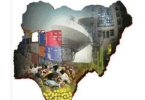Nigerian foods are as diverse as the many ethnic groups that comprise this great nation. With well over 300 ethnic groups, the country can boast of a rich assortment of spices, flavors and natural foods that are irresistible. It will however interest you to know that the rich history of Nigerian food was heavily influenced by trade with Europeans, as far back as the 14th Century.
Let us take a deep dive into the rich history of Nigerian food. We will trace the origins of common staples eaten in this country. How the climate, environment and local resources have heavily influenced the type of foods eaten in each region will also be made clear.
A Journey Through the Different Regions of Nigeria and their Vegetations
A journey through Nigeria’s landscape shows an interesting variation of vegetation from the southern coasts to the northern desert regions. It begins with the mangrove swamp forests that line the fringes of the Atlantic ocean (south of the country) and the Niger Delta. Going further inwards, one would next encounter the tropical rainforests.
Towards the Middle Belt region, the forests lead into sweeping savannas and a plateau, culminating in the Shebshi Mountains (northeastern Nigeria). Finally the extreme north becomes drier; and forms a long border with the Sahara Desert.
The prevailing climate in each region strongly influences the vegetation found there. It also influences the staple foods, vegetables, fruits, spices and animal protein available in each region. Even though Nigeria falls within the tropical zone, the climate becomes progressively drier as one moves from the coast northwards.
The coastal regions are very humid, and the nights are typically hot. Further inland – especially in the rainforest zone – the rainy season normally runs from April to October. A dry season follows from November to March.
Nigeria is also abundantly blessed with a network of rivers that allow fishing activities to thrive. This is particularly true of dwellers along the banks of rivers Niger and Benue (the biggest rivers in Nigeria). Besides being a transportation highway, the river Niger for instance is home to the Nile perch, carp and catfish. The country’s rivers also provide water for irrigation of crops.
How Trade with Europeans Heavily Influenced the History of Nigerian Food
Historical findings have revealed that a good number of Nigeria’s iconic staples did not originate from Nigeria itself. Before the Europeans came to trade on the coast of West Africa, the region’s major staple foods included rice, millet, and lentils. But around the 1400s, Portuguese traders and explorers arrived.
While the transatlantic slave trade ultimately became their main concern, they brought along foods such as cassava, beans and maize (from the Americas). These were introduced into Nigeria (and the rest of West Africa) and grown from there. Furthermore, Asian spices such as cinnamon, nutmeg and pepper were also introduced into West Africa by the European explorers.
Nigeria’s Staple Foods by Region
Over the years, the heavy tuber crops (yam, potatoes, cassava and cocoyam) began to thrive more in the forest and guinea savanna regions. These are within the southwest, southeast, South-South and Middle Belt regions. These regions are typically occupied by the Yorubas, Igbos, Niger Delta tribes, and coastal tribes. There is also an abundance of spices, herbs, vegetables and perennial fruits in these regions.
While grains such as millet, sorghum, guinea corn, and rice thrive more in the savanna regions further northwards (where there is less rainfall). These regions are occupied by the Hausa, Fulani, Kanuri and several other northern tribes. A wide range of vegetables (including tomatoes and onions) are also grown in these regions, along with many spices (ginger and garlic for instance). Again the grassland sustains cattle rearing in northern Nigeria.
Many of these crops have become seasonal; but fruits are abundant throughout the year. In general, there is not one, but several traditional dishes across Nigeria, prepared with the local staples of each region. As such, each region has its favorite/popular foods which are intertwined with their religions, customers and tradition.
Yet again, these local dishes are made available depending on the season that favors the major staple ingredient. Note that there is the lean or ‘hungry’ season (before the rains begin in March). The ‘surplus’ season comes after the harvest in October and November.
Finally, seafood is delightfully abundant amongst the coastal tribes and the Niger Delta people. Namely the Ijaws, Ilajes, Ibibio, Efik, Itsekiri, Egun (Badagry) and related tribes. You will also find an abundance of palm oil and plantains in these regions.
Foods in Northern Nigeria
Get ready to be delighted with not just a rich history of Nigerian food up North. But the foods on offer are quite rich and filling, in spite of the hot and harsh climate.
Their staple foods include the iconic ‘tuwo’ which comes in three forms. There is tuwo shinkafa (rice pudding), tuwo masara (cornmeal), and tuwo dawa (sorghum flour). These are served with spicy soups such as miyan kuka (baobab leaf soup), miyan taushe (pumpkin soup), and miyan zogale (spinach soup). Groundnut soup is also commonly served there.
Meat snacks such as kilishi (spicy dried meat) and suya (grilled skewered meat) have gone beyond their origins in northern Nigeria. Now, they have become national delicacies. Not forgetting that a wide range of aromatic spices such as ginger, garlic, cloves, cumin and many others, are incorporated into their meals. The end result is a range of rich and unforgettable flavors.
Foods in Southwest Nigeria
The Yoruba people of southwest Nigeria are ready to daze you with a full range of tasty meals. These rich and satisfying foods are prepared with a fairly broad range of vegetables, spices and herbs. They particularly value having enough pepper in their meals.
You will encounter numerous tasty southwestern Nigerian cuisine. The likes of pounded yam, Amala (yam flour), one-pot Jollof rice, Ofada rice, Asaro (yam/plantain/cocoyam porridge), ikokore (water yam porridge), Eba (steamed cassava), Eko (maize pudding) and Adalu (maize and bean stew). Moin-moin and Akara (both made from blended beans) are also very popular delicacies.
Their soups and stews are satisfying. They include Ewedu (jute leaf soup), Efo Riro (spinach soup), Egusi (melon soup) and Ila Asepo (Okro variety soup). Fried and roasted plantains are also quite common.
Foods in Southeast Nigeria
The Igbos will steal your heart with a broad assortment of super-rich and flavorful soups. They are often full of meat, fish, different kinds of vegetables, herbs and spices cooked in plenty of palm oil. Just a few of their tasty soups and stews include ofe onugbu (bitterleaf soup), ofe nsala (white soup), and ofe oha (oha soup).
Their staple foods such as Fufu (semi-solid food made from yam, cassava, plantain or cocoyam) or Eba normally go with these soups and stews. Yet again, there are other exceptionally rich and spicy foods on display. Ukwa (breadfruit porridge), Abacha (African salad), Ugba, Okpa (bambara nut pudding), Pepper soup and Nkwobi (spicy cow feet) are typical examples. They are often served with palm wine (and other drinks).
Foods in the South-South Region of Nigeria
The South-South region is the natural home of seafood, being located along the coastal waters of Nigeria. As such, expect to be delighted with tasty and spicy dishes that often include plenty of fish (and other seafood). They include fish pepper soup, Fisherman soup, grilled fresh fish, Edikang-ikong (a vegetable and protein stew with many ingredients), and plenty of plantains.








